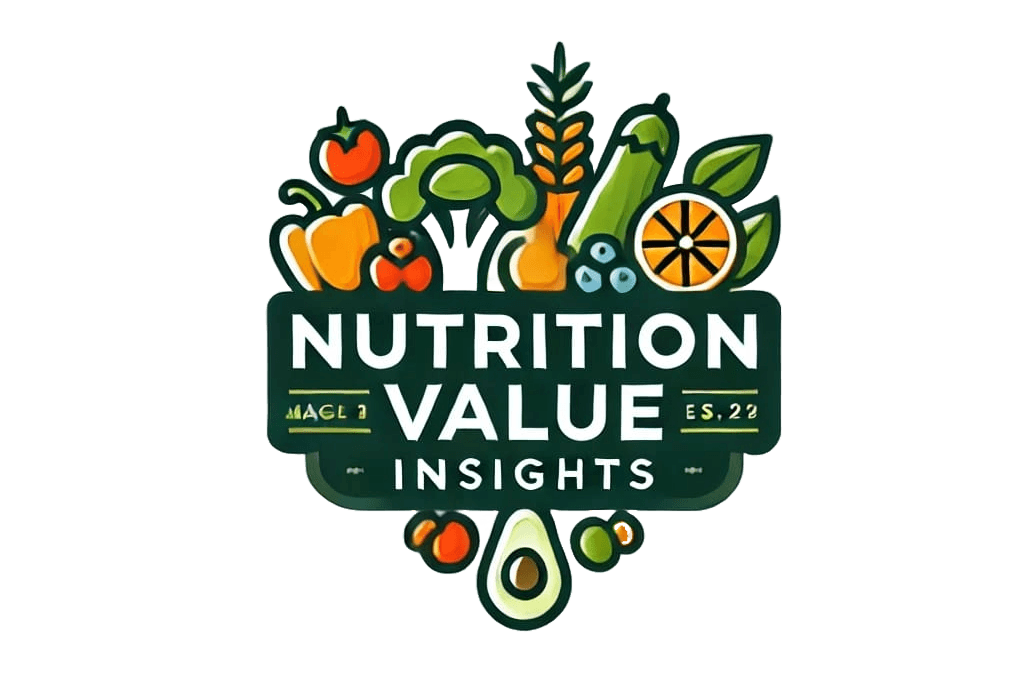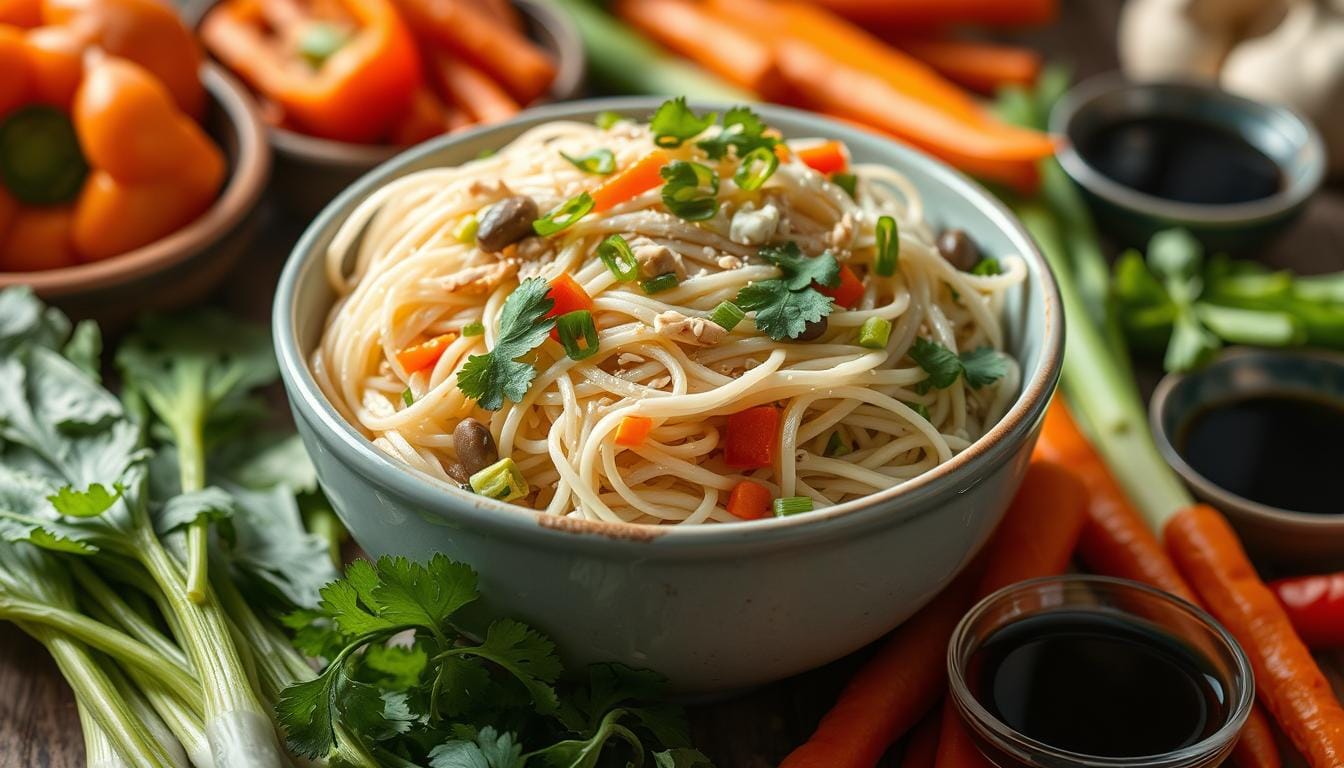Rice Noodles Nutrition Information : Calories, Benefits, and Healthy Tips
Rice noodles are loved in many parts of the world. They are packed with nutrients, making them great for those who care about their health. Each 100g of rice noodles has 364 calories, thanks to their 80g of carbs. They also have just 1g of fat and 5g of protein.
What’s more, rice noodles are gluten-free. This makes them perfect for people with gluten issues. They have a glycemic index of 53, which is considered medium. This means they can help keep blood sugar levels stable, which is good for those with diabetes or watching their carb intake.
They are also easy to digest because of their low fat content. This makes them a great choice for anyone with a sensitive stomach.
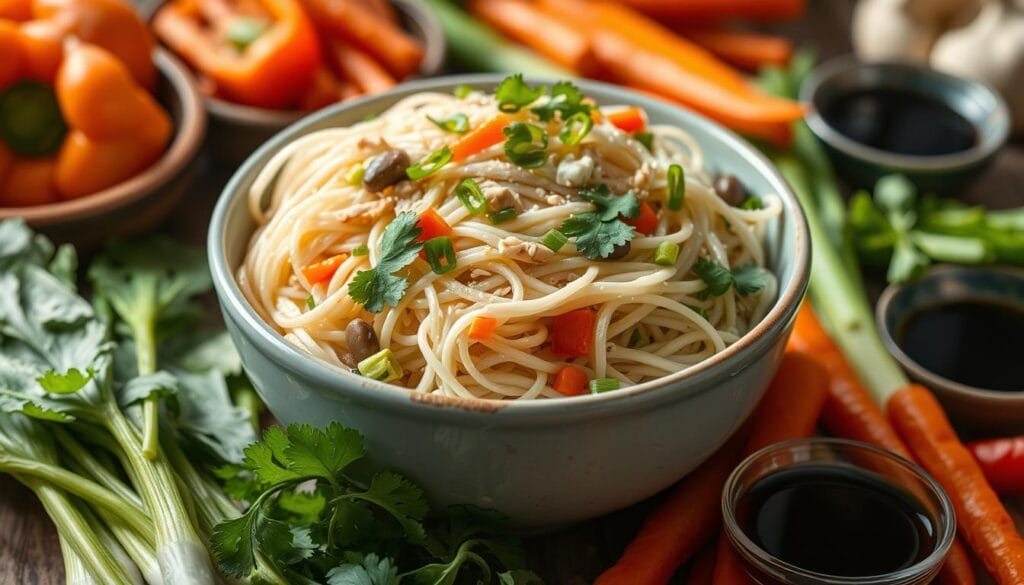
Table of Contents
Understanding Rice Noodles Nutrition Overview
Rice noodles are a favorite in Asian dishes for their soft texture and taste. They’re made from rice flour and water, making them gluten-free and light. Even though they’re not packed with nutrients, they have some benefits worth noting.
Caloric Content and Macronutrients
A cooked cup of rice noodles has about 187 calories. They have 41.8g of carbs, 3.1g of protein, and 0.4g of fat. They have very little fiber, with about 1.75g per serving. Compared to regular pasta, they have similar calories and fat but less protein and more sodium.
Vitamins and Minerals Profile
Rice noodles don’t have a lot of vitamins and minerals, but they do offer some. A cup of cooked noodles has 438mg of sodium, 20mg of calcium, and 55mg of potassium. They also have small amounts of B vitamins like thiamin, riboflavin, and niacin.
Comparison with Other Noodle Types
| Noodle Type | Calories (per 100g) | Carbs (g) | Protein (g) | Fat (g) |
|---|---|---|---|---|
| Rice Noodles | 364 | 80 | 5 | 1 |
| Wheat Pasta | 371 | 71 | 13 | 1.2 |
| Egg Noodles | 385 | 64 | 11 | 4.3 |
The table shows rice noodles are similar to wheat pasta in calories and carbs but have less protein and more sodium. Egg noodles, however, have more calories and fat than rice and wheat noodles.
Health Benefits of Rice Noodles Nutritional
Rice noodles are a great choice for health. They are gluten-free, which is good for people with celiac disease or gluten intolerance. Each cup of cooked noodles has 187 calories, making them a low-fat, low-calorie option.
They have complex carbohydrates for sustained energy. They also have 1.75g of fiber per serving, which helps with digestion. Plus, they have 3.1g of protein per serving, making them good for a balanced diet.
Rice noodles have less sodium than other noodles, with only 438mg per serving. They are also free from common allergens like gluten. This makes them a good choice for those with dietary restrictions.
“Rice noodles are a great alternative to traditional pasta and can be a valuable addition to a healthy, balanced diet.”
If you want to manage your weight, follow a gluten-free diet, or just try something new, rice noodles are a great option. They are delicious and good for you.
Glycemic Index and Blood Sugar Impact
Understanding the glycemic index (GI) of rice noodles is key, especially for those with diabetes or watching their carb intake. The GI shows how fast a food raises blood sugar, from 0 to 100. Rice noodles have a medium GI of about 53, leading to a moderate increase in blood sugar.
Understanding GI Levels
Foods with a low GI (55 or less) are best, as they digest slowly and don’t cause quick blood sugars spikes. Rice noodles, with a GI of 56-69, are okay in a balanced diet with other low-GI foods. High GI foods (70 and above) can cause big blood sugar swings and should be eaten less often.
Managing Blood Sugar Response
For those with diabetes or watching their blood sugar, watch your rice noodle portions. Eating them with foods high in fiber or protein can slow down carb absorption and prevent blood sugar spikes. Also, check your blood sugar after meals to see how different foods affect you.
Diabetic Considerations
Rice noodles can be part of a balanced, low-GI diet for diabetics. But, it’s important to work with a healthcare professional to find the right portion sizes. They can help you fit rice noodles into a meal plan that keeps your blood sugar in check.
| Food Item | Glycemic Index | Glycemic Load |
|---|---|---|
| Rice Noodles | 53 (medium) | 15 (medium) |
| Whole Wheat Pasta | 49 (low) | 13 (medium) |
| Quinoa | 53 (medium) | 18 (medium) |
| Oats | 55 (medium) | 13 (medium) |
| Lentils | 29 (low) | 5 (low) |
Rice Noodles: Protein and Carbohydrate Content
Understanding the nutritional profile of rice noodles is key. They offer a balance of protein and carbohydrates. Rice noodles are a great alternative to traditional wheat-based pasta, but their macronutrient composition is different.
A 2-ounce (56g) serving of cooked rice noodles has about 3.1g of protein and 41.8g of carbohydrates. This shows that rice noodles are mainly complex carbohydrates. They provide a steady energy supply for your body.
| Nutrient | Amount per 2-ounce Serving |
|---|---|
| Calories | 187 |
| Protein | 3.1g |
| Carbohydrates | 41.8g |
| Fiber | 1.75g |
| Fat | 0.4g |
| Sodium | 438mg |
Compared to wheat-based pasta, rice noodles have less protein. A similar serving of wheat pasta has about 7g of protein. This highlights the lower protein content in rice noodles.
The carbohydrate content in rice noodles makes them a good energy source. However, it’s crucial to control portions and eat them as part of a balanced diet for the best nutrition.
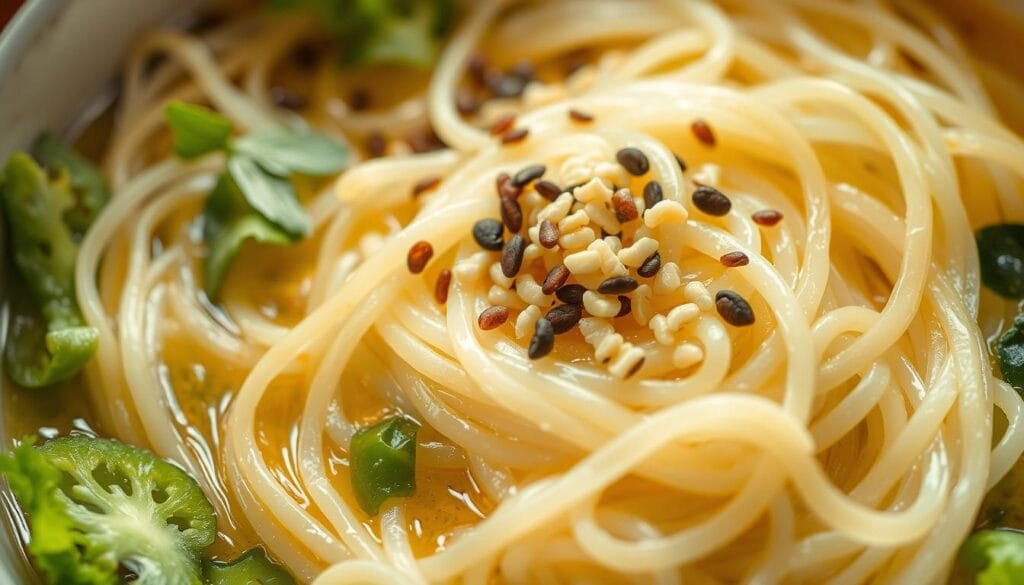
“Rice noodles are a versatile and gluten-free option, but they shouldn’t be considered a health food due to their low protein and high carbohydrate content. Moderation and a balanced diet are key for ensuring overall well-being.”
Dietary Considerations and Restrictions
Rice noodles are great for many diets. They are gluten-free, which is perfect for people with celiac disease or gluten sensitivity. This makes them a safe and tasty choice for those who can’t eat gluten.
Gluten-Free Properties
Gluten-free rice noodles don’t have the protein that can cause problems for people with gluten intolerance. This makes them a good choice for many different diets and preferences.
Allergen Information
Rice noodles are usually safe for most people, but watch out for cross-contamination. Always check the labels to make sure they’re made in a place that doesn’t have your allergens, like soy, nuts, or dairy.
Special Diet Compatibility
Rice noodles are easy to fit into many special diets. They’re good for vegetarians and vegans because they don’t have animal products. But, they do have a lot of carbs, so people on low-carb diets need to watch their portions.
| Dietary Consideration | Rice Noodle Compatibility |
|---|---|
| Gluten-free | ✓ |
| Vegetarian | ✓ |
| Vegan | ✓ |
| Low-carb/Keto | Requires Portion Control |
“Dietary restrictions and allergies are important considerations when choosing the right noodles for your needs. Rice noodles offer a versatile and inclusive option for many individuals.”
Proper Storage and Shelf Life
Proper storage is crucial for keeping rice noodles fresh. Dried noodles can stay good for up to two years in an airtight container. Cooked noodles should be refrigerated in a sealed container and used within five days. This keeps them from getting soggy and losing flavor.
Don’t store rice noodles near foods with strong smells. They can pick up odors easily. Fresh noodles should be used within four days in the fridge. Dried noodles can last months and are safe to eat until their expiration date.
Dried rice noodles last longer than fresh ones. They can stay good for a year in a cool, dry spot. Fresh noodles last about five days in the fridge. Cooked noodles can last 3-4 days in the fridge or up to two months in the freezer.
By storing rice noodles correctly and checking expiration dates, you can keep them fresh. This way, they’re always ready for your favorite Asian dishes.
“Proper storage is the key to enjoying the full shelf life of rice noodles. By keeping them in a cool, dry place, you can savor their fresh taste for months to come.”
Healthy Cooking Methods and Tips
Choosing the right cooking methods is crucial for making tasty and healthy rice noodle dishes. Here are some tips to help you get the most out of your rice noodle recipes:
Best Preparation Techniques
Boiling or stir-frying your rice noodles with little oil is a healthier choice. It keeps their natural flavors and nutrients intact. Try adding rice noodles to soups, salads, or spring rolls for a variety of meals.
Nutritious Pairing Suggestions
- Pair your rice noodles with fresh vegetables for a nutrient-rich dish.
- Lean proteins like grilled chicken, shrimp, or tofu add a good balance of nutrients.
- Herbs and spices can enhance your rice noodle dishes without using heavy sauces.
Portion Control Guidelines
Controlling portion sizes is important with rice noodles. Aim for 2 ounces (about 190 calories) per serving. This helps balance your meal with other nutrient-dense foods.
By using these healthy cooking tips, you can enjoy delicious rice noodles while keeping them nutritious. Try out different recipes and techniques to find your favorite healthy rice noodle dishes.
Nutritious Rice Noodle Alternatives
Rice noodles are common in many Asian dishes. But, there are healthier options that offer different benefits. If you want to try something new, here are some great choices:
- Zucchini Noodles (Zoodles) – These noodles are low in carbs and calories but rich in vitamins and minerals. They’re a great gluten-free and low-calorie option.
- Shirataki Noodles – Made from konjac yam, these noodles are very low in carbs and calories. They’re perfect for those watching their blood sugar.
- Soba Noodles – Made from buckwheat flour, soba noodles have a lower glycemic index. They also offer more protein than regular rice noodles.
- Whole Grain Pasta – Not a direct substitute, but whole grain pasta has more fiber. This can help manage blood sugar and promote health.
These alternatives not only boost nutrition but also add variety to your dishes. They’re great for reducing carbs, increasing fiber, or just trying something new. These options are definitely worth exploring.
| Noodle Type | Nutrition Profile | Key Benefits |
|---|---|---|
| Zucchini Noodles | Low in carbs, calories, and high in vitamins and minerals | Gluten-free, low-calorie substitute for rice noodles |
| Shirataki Noodles | Very low in carbs and calories, made mostly of water and fiber | Excellent choice for managing blood sugar levels |
| Soba Noodles | Lower glycemic index, provide more protein than rice noodles | Healthier alternative with added nutritional benefits |
| Whole Grain Pasta | Higher in fiber, which helps manage blood sugar levels | Offers more fiber and overall health benefits |
Exploring these alternatives can make your meals more interesting and healthy. Whether you’re looking to cut carbs, boost fiber, or just experiment, these options are great for your cooking adventures.
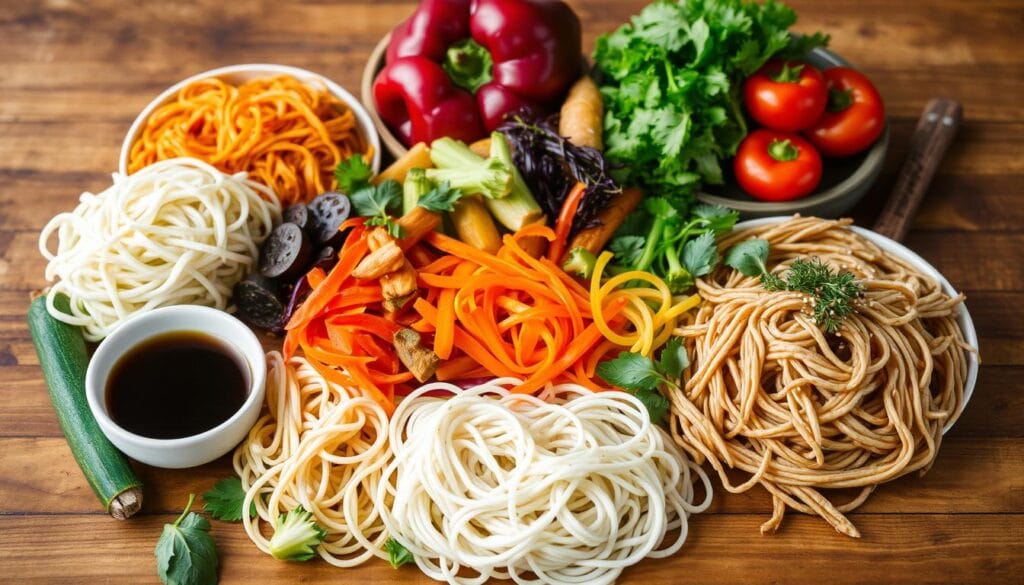
Conclusion
Rice noodles are a great, gluten-free choice for your diet. They have moderate calories and a medium glycemic index. This means they give you energy that lasts and are easy to digest. But, they have less protein and some nutrients than whole grains.
Adding rice noodles to your meals in the right amounts can be good for you. Just make sure to pair them with other healthy foods. This way, you get the most out of them in your diet.
The rice noodles nutrition and health benefits of rice noodles make them a great addition to your cooking. With a bit of thought and creativity, you can use rice noodles to help keep you healthy.
FAQ
What is the caloric content and macronutrient profile of rice noodles?
Rice noodles have 364 calories per 100g. They contain 80g of carbs, 5g of protein, and 1g of fat. Each serving also has 1g of fiber and 1g of sugar.
What are the key vitamins and minerals found in rice noodles?
Rice noodles are rich in minerals. They have 5mg of sodium, 20mg of calcium, and 55mg of potassium per serving.
How do rice noodles compare nutritionally to other noodle types?
Rice noodles have similar calories and fat to regular pasta. But they have less protein and more sodium.
What are the health benefits of incorporating rice noodles into your diet?
Rice noodles are gluten-free. They provide sustained energy and are low in fat. They’re also easy to digest.
How does the glycemic index of rice noodles affect blood sugar levels?
Rice noodles have a glycemic index of 53. This means they moderately raise blood sugar levels. Diabetics should watch their portions and pair them with fiber or protein.
What is the protein and carbohydrate content of rice noodles?
Rice noodles have 5g of protein and 80g of carbs per 100g. They’re a good source of complex carbs for energy.
Are rice noodles suitable for people with dietary restrictions?
Yes, rice noodles are gluten-free. They’re good for those with celiac disease or gluten sensitivity. But, they might be cross-contaminated during making.
How should rice noodles be stored to maintain freshness?
Store dried rice noodles in an airtight container in a cool, dry place for up to two years. Cooked noodles should be refrigerated in an airtight container for three to five days.
What are some healthy preparation methods and nutritious pairings for rice noodles?
Boil or stir-fry rice noodles with little oil for a healthier option. Pair them with veggies, lean proteins, and herbs. Use a standard serving size of 2 ounces (about 190 calories) and balance with other foods.
What are some alternatives to rice noodles that offer similar nutritional benefits?
Good alternatives include zucchini noodles (zoodles), shirataki noodles, and soba noodles. They have less carbs or more protein and fiber.
DID OUR INFORMATION HELP YOU ?
There are no reviews yet. Be the first one to write one.
